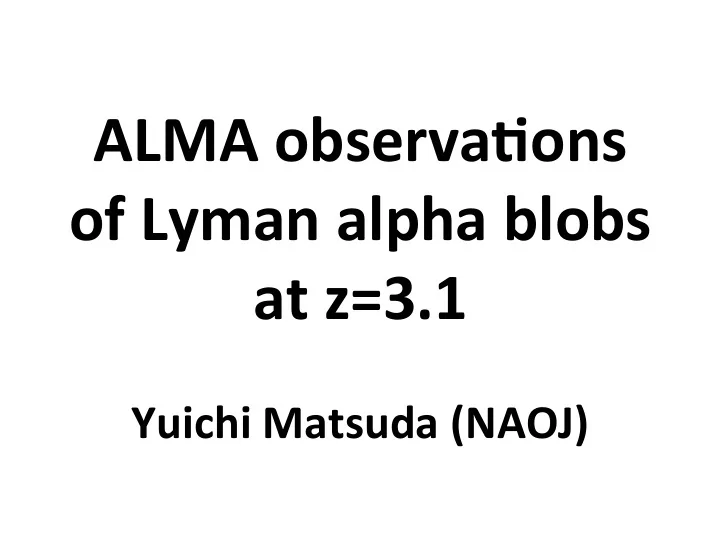

ALMA observa,ons of Lyman alpha blobs at z=3.1 Yuichi Matsuda (NAOJ)
Lyman alpha blobs (LABs) • Dura%on %me-scale~0.1Gyr (1% of Cosmic %me)? • Cosmic cherry blossoms (3 days per year – 1%)? NB Ly ! emitter Erb+11 Steidel+00 6 Continuum ! selected z=2.3 Matsuda+04 H ayes+11 4 BLOB 1 2 Comoving Mpc BLOB 4 0 BLOB 5 BLOB 6 BLOB 2 ! 2 BLOB 3 ! 4 ! 6 ! 6 ! 4 ! 2 0 2 4 6 Comoving Mpc
Summary • Lya halo is ubiquitous • ALMA started to detect dusty sources in LABs • One ALMA source in a filamentary LAB may be in transi,on phase from dusty starburst to passive galaxy
Lyman alpha halo is ubiquitous Lya halo around distant galaxies Lya halo around the Earth Steidel+00 PROCYON Kameda+17 Matsuda+04 H ayes+11 Earth Lya halo is x50 bigger than the Earth Lya halo is x50 bigger than galaxies 300 kpc Size difference is 10 13
ALMA observa,ons of LABs Ø ALMA Band 8 [CII] (Umehata+17) Ø ALMA Band 7 cont + [NII] (Geach+16, Umehata+17, Ao+17, See also Yiping Ao’s poster Matsuda+ in prep) Ø ALMA Band 3 cont + CO(4-3) (Kato+ in prep) ALMA Band 7 FoV ALMA Band 7 FoV ALMA Band 7 FoV ALMA Band 7 FoV LAB02 LAB01 LAB05 LAB18 100 kpc 100 kpc LAB01 1" Taper LAB02 1" Taper LAB05 1" Taper LAB18 1" Taper Lya Lya ~1mJy Lya Lya 1 ~2mJy ~1-4mJy ~0.5mJy 2 1 0.3 0.5 0.3 0.5 0.3 0.5 0.3 0.5 1 1 2 3 3 4 rms=74microJy/beam rms=74microJy/beam rms=75microJy/beam rms=75microJy/beam
Filamentary LAB at z=3.1 (LAB18) Subaru rest 1575 Å HST rest 1985 Å Subaru Ly α cyan=850 μ m dust a b c d 30 kpc 30 kpc 30 kpc
ALMA deep 3mm observations 5 hrs on-source (PI: Yuta Kato) rest 660 μ m rest 740 μ m CO J=4-3 a b Ly α c d 30 kpc 30 kpc 30 kpc
large dust emissivity index β =2.3 transi,on phase 3.5 LAB18.b z<0.006 logL FIR (L o ) =8-11 from dusty starburst z<0.04 LIRGs z<0.5 LIRGs to passive galaxy? z<0.3 ULIRGs 3 LAB18.b 2.5 ULIRGs β 2 β ISM =1.8 1.5 1 0.5 10 20 30 40 50 60 Temperature [K] Temperature [K] Ø L IR(8-1000 μ m) = (2.7 ± 0.4) × 10 12 L o (T d =32.5 ± 0.6 K 、 β =2.3 ± 0.1)
Short gas depletion time τ dep =16Myr transi,on phase Velocity [km/s] 1500 1000 500 0 -500 -1000 from dusty starburst 0.2 LAB18.b to passive galaxy? Herschel/SPIRE 13 . log L FIR(8-1000um) [L o ] 0.15 250,350,500 μ m CO J=4-3 SMGs (Kato et al. 2016) Flux Density [mJy/beam] 0.1 LAB18.b ULIRGs 0.05 12 0 LIRGs -0.05 ( τ = 16 Myr) z CO =3.093±0.001 Greve et al. (2014) LAB18.b 11 z<0.1 (U)LIRGs -0.1 ( τ = 100 Myr) (z Ly α =3.104) z>1 DSFGs ( τ = 200 Myr) z>1 lensed DSFGs 8 9 10 11 -0.15 112 112.2 112.4 112.6 112.8 113 113.2 log L’ CO(4-3) [K km s -1 pc 2 ] Frequency (Obs) [GHz] Ø M gas = (4.4 ± 0.3) × 10 9 M o (r 41 = 0.41, α =0.8) Ø SFR = 273 ± 35 M o /yr τ dep = M gas /SFR = 16 ± 2 Myr
Summary • Lya halo is ubiquitous • ALMA started to detect dusty sources in LABs • One ALMA source in a filamentary LAB may be in transi,on phase from dusty starburst to passive galaxy
β reflects dust chemical composition Laboratory experiment κ d ( κ 850 = 0.4-8 cm 2 g -1 ) Mass Absorp%on Coefficient Mg-rich steep amorphous silicate (Opacity) β >2 (1-x) MgO – x SiO 2 Mg 1.1 Fe 0.9 SiO 4 β ~2 ( κ 850 ~0.4 cm 2 g -1 ) Wavelength Demyk et al. (2017)
Recommend
More recommend